What are they?
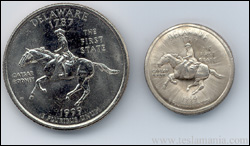

 Shrunken coins are genuine coins that have been reduced to 65-95% of their original diameter using huge magnetic fields. Over the last year, we began offering shrunken coins as educational, scientific, and coin collecting novelties. A significant number of these are now in the hands of experimenters and collectors throughout the world. Shrunken coins have been featured in Coin World (November 25, 2002) and in the January-March, 2003 issue of Extraordinary Technology magazine. This article will briefly explain how these unique coins are produced and how they can be recognized so that they won’t be confused with true error coins.
Shrunken coins are genuine coins that have been reduced to 65-95% of their original diameter using huge magnetic fields. Over the last year, we began offering shrunken coins as educational, scientific, and coin collecting novelties. A significant number of these are now in the hands of experimenters and collectors throughout the world. Shrunken coins have been featured in Coin World (November 25, 2002) and in the January-March, 2003 issue of Extraordinary Technology magazine. This article will briefly explain how these unique coins are produced and how they can be recognized so that they won’t be confused with true error coins.
Are there any shrunken error coins?
 We don’t shrink error coins since the shrinking process relies upon symmetry for balancing forces. It would also be a shame to further alter rare error coins. However, once in a while the shrinking process fails to work properly on a coin that otherwise appears normal. For example, clad coins sometimes contain hidden defects that are not readily apparent. During the shrinking process, the inner and outer layers may partially detach, resulting in a very strange looking “mutant coin”, such as this Kentucky state quarter.
We don’t shrink error coins since the shrinking process relies upon symmetry for balancing forces. It would also be a shame to further alter rare error coins. However, once in a while the shrinking process fails to work properly on a coin that otherwise appears normal. For example, clad coins sometimes contain hidden defects that are not readily apparent. During the shrinking process, the inner and outer layers may partially detach, resulting in a very strange looking “mutant coin”, such as this Kentucky state quarter.
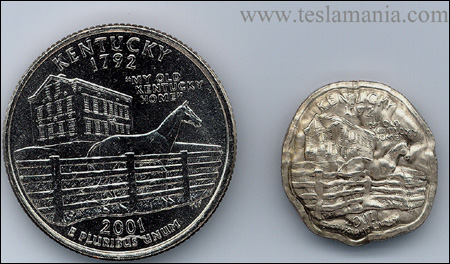
Do you suppose there might be a market for “error” shrunken coins??
How are they shrunk?
 Everyone has played with a pair of permanent magnets and felt how strongly they attract or repel each other. Although the forces that repel small magnets may appear quite strong, magnetic fields that are thousands of times stronger can be created by forcing an electric current through a coil of wire, forming a powerful electromagnet. Increasing the current increases the magnetic field, and a really huge current can create an ultrastrong magnetic field. Magnetic fields of this magnitude have the ability to overcome the yield strength of any metal. Although it may be hard to believe, a properly-shaped ultrastrong magnetic field can actually reshape a coin using only invisible “dies” of pure magnetic force!
Everyone has played with a pair of permanent magnets and felt how strongly they attract or repel each other. Although the forces that repel small magnets may appear quite strong, magnetic fields that are thousands of times stronger can be created by forcing an electric current through a coil of wire, forming a powerful electromagnet. Increasing the current increases the magnetic field, and a really huge current can create an ultrastrong magnetic field. Magnetic fields of this magnitude have the ability to overcome the yield strength of any metal. Although it may be hard to believe, a properly-shaped ultrastrong magnetic field can actually reshape a coin using only invisible “dies” of pure magnetic force!
 Prior to shrinking, a coin is carefully centered within a coil of insulated copper wire. The coil is then bolted securely to heavy electrical conductors inside a bulletproof blast chamber. Using a high voltage energy source, a huge current is abruptly forced into the coil, creating an ultrastrong pulsed magnetic field. The peak current through the coil may be greater than 120,000 times the current drawn by a typical 100-watt light bulb. This rapidly changing powerful magnetic field also induces an even larger current to flow within the coin. The current flowing within the coin can easily exceed one million amperes, causing the coin to become a powerful electromagnet as well.
Prior to shrinking, a coin is carefully centered within a coil of insulated copper wire. The coil is then bolted securely to heavy electrical conductors inside a bulletproof blast chamber. Using a high voltage energy source, a huge current is abruptly forced into the coil, creating an ultrastrong pulsed magnetic field. The peak current through the coil may be greater than 120,000 times the current drawn by a typical 100-watt light bulb. This rapidly changing powerful magnetic field also induces an even larger current to flow within the coin. The current flowing within the coin can easily exceed one million amperes, causing the coin to become a powerful electromagnet as well.
 The magnetic fields of the coil and the coin violently repel each other, resulting in almost unimaginable forces that easily overcome the yield strength of the metal in the coin. These forces evenly squeeze the coin inward, almost instantly shrinking it into a smaller diameter while simultaneously causing it to become thicker. These same forces also drive the coil outwards, causing it to explode in a potentially deadly spray of high velocity wire fragments. All this takes place in about 20 millionths of a second, and is accompanied by a bright blue-white flash and a loud BANG! When the dust settles, a hot and shrunken coin rests at the bottom of the chamber. Amazingly, the features of a shrunken coin are fully preserved in spite of its explosive birth.
The magnetic fields of the coil and the coin violently repel each other, resulting in almost unimaginable forces that easily overcome the yield strength of the metal in the coin. These forces evenly squeeze the coin inward, almost instantly shrinking it into a smaller diameter while simultaneously causing it to become thicker. These same forces also drive the coil outwards, causing it to explode in a potentially deadly spray of high velocity wire fragments. All this takes place in about 20 millionths of a second, and is accompanied by a bright blue-white flash and a loud BANG! When the dust settles, a hot and shrunken coin rests at the bottom of the chamber. Amazingly, the features of a shrunken coin are fully preserved in spite of its explosive birth.
Does the shrinking process work on all coins?
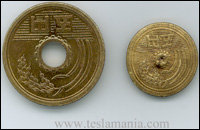

 The process works very well with most US and foreign coins and metal tokens. Although the process uses magnetic fields, the coin’s electrical conductivity determines how well it will shrink. Metals that are good electrical conductors, such as copper, silver, aluminum, or gold, work best. Poorer conducting copper-nickel alloys or plated steel coins may shrink only slightly. While older 90% silver coins such as Morgan Dollars work very well, coins with only 40% silver content may lose surface features due to their lower melting temperature. Coins with metals of lower melting temperature, such as copper plated zinc pennies, are simply destroyed in an explosion of molten zinc. Coins with higher features, such as proof coins, tend not to work as well as circulating coins. Coins or tokens with centered holes often result in the hole partially or entirely closing. The outer and inner parts of bimetal coins often shrink to a different degree, causing the center to loosen and sometimes be completely freed from the outer ring.
The process works very well with most US and foreign coins and metal tokens. Although the process uses magnetic fields, the coin’s electrical conductivity determines how well it will shrink. Metals that are good electrical conductors, such as copper, silver, aluminum, or gold, work best. Poorer conducting copper-nickel alloys or plated steel coins may shrink only slightly. While older 90% silver coins such as Morgan Dollars work very well, coins with only 40% silver content may lose surface features due to their lower melting temperature. Coins with metals of lower melting temperature, such as copper plated zinc pennies, are simply destroyed in an explosion of molten zinc. Coins with higher features, such as proof coins, tend not to work as well as circulating coins. Coins or tokens with centered holes often result in the hole partially or entirely closing. The outer and inner parts of bimetal coins often shrink to a different degree, causing the center to loosen and sometimes be completely freed from the outer ring.

How can shrunken coins be recognized?


 The most obvious characteristic is their smaller diameter. Shrunken coins have the same weight and density as a normal coin, but they are thicker. The copper center of US clad coins is a much better electrical conductor than the outer copper-nickel layers. This causes the center to shrink a bit more, becoming indented similar to the filling in an Oreo cookie. Because the coin’s features cause slight force imbalances, the coin’s rim may also become slightly scalloped. All three of these effects can be seen in the before and after scan of the edges of a quarter.
The most obvious characteristic is their smaller diameter. Shrunken coins have the same weight and density as a normal coin, but they are thicker. The copper center of US clad coins is a much better electrical conductor than the outer copper-nickel layers. This causes the center to shrink a bit more, becoming indented similar to the filling in an Oreo cookie. Because the coin’s features cause slight force imbalances, the coin’s rim may also become slightly scalloped. All three of these effects can be seen in the before and after scan of the edges of a quarter.
 Previously mirror-like surfaces acquire a frosted appearance due to microscopic dislocations in the surface of the metal. Also, faint lines, called Luders Lines, may radiate from the center of the coin, reflecting localized plastic deformation during the shrinking process. An interesting example is this Kennedy clad half dollar, where Kennedy’s bust appears “haloed” by radiating Luders Lines.
Previously mirror-like surfaces acquire a frosted appearance due to microscopic dislocations in the surface of the metal. Also, faint lines, called Luders Lines, may radiate from the center of the coin, reflecting localized plastic deformation during the shrinking process. An interesting example is this Kennedy clad half dollar, where Kennedy’s bust appears “haloed” by radiating Luders Lines.
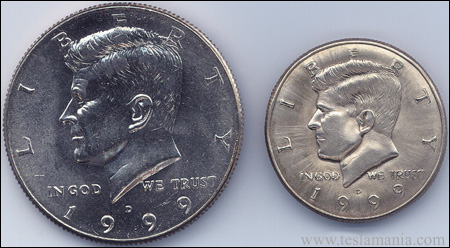
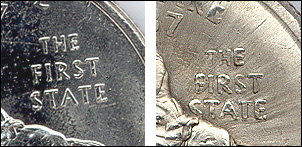

 Finally, certain features of a coin may actually shift relative to one another, particularly in clad coins. This effect can be seen in the close-up view of the shifted state motto in the Delaware state quarter pictured to the right.
Finally, certain features of a coin may actually shift relative to one another, particularly in clad coins. This effect can be seen in the close-up view of the shifted state motto in the Delaware state quarter pictured to the right.
 Other coins, such as this Sacagawea dollar, show a minimum of feature shifting and Luders lines.
Other coins, such as this Sacagawea dollar, show a minimum of feature shifting and Luders lines.
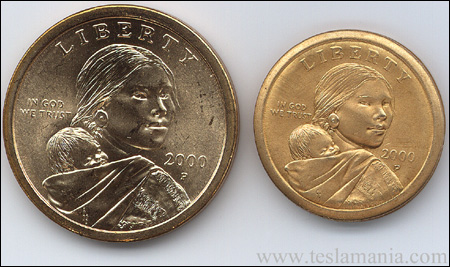
Need more information?

Stoneridge Engineering is the exclusive source for “Electromagically” shrunken coins. Custom shrinking is also available.

